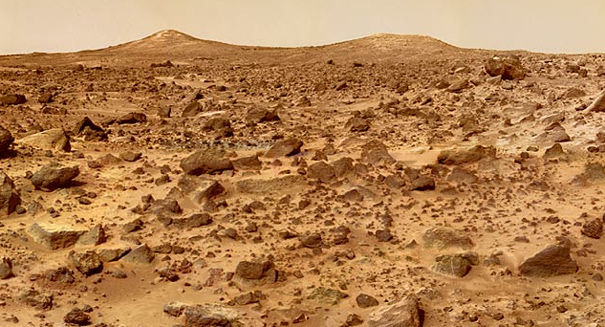
Curiosity discovers additional evidence of past water on Mars.
Last week, the Curiosity rover made its first of five planned pit stops on the way to the Red Planet mountain on Mars. During this visit, it has found more evidence of ancient Martian water.
“We examined pebbly sandstone deposited by water flowing over the surface, and veins or fractures in the rock,” Curiosity science team member Dawn Sumner, of the University of California, Davis, said in a statement. “We know the veins are younger than the sandstone because they cut through it, but they appear to be filled with grains like the sandstone.”
The rover team had launched Curiosity to Mars back in November 2011 with the goal of making its way to Mount Sharp, where it would then study the landscape’s many layers for clues about the Red Planet’s changing environmental conditions. Curiosity landed just 5.8 miles away from Mount Sharp on the Gale Crater on August 2012, where it began a search around the area for microbial life forms and signs of water. It did find that a location near where it landed called Yellowknife Bay was wet and habitable billions of years ago.
Now, the rover team is working to understand the geology between the two locations, planning out five “wave points” along the route. The first was on September 19 and had been dubbed “Darwin.” “We want to understand the history of water in Gale Crater. Did the water flow that deposited the pebbly sandstone at Waypoint 1 occur at about the same time as the water flow at Yellowknife Bay?” Sumner said.
The water the research team believes Curiosity had found was in a lake, calm and neutral water where microbes could live. One hint was the rocks that Curiosity drilled into was a mudstone, and inside researchers had found clay minerals. “It’s amazing that we found a mudstone,” said presenter Aileen Yingst, a Curiosity science team member from the Planetary Science Institute inTucson, Ariz. According to Yingst, mudstones have fine grains, indicating that they settled down slowly and the rock formed over time. On Earth, this generally occurs due to wind or water, and the scientists are placing bets on water as well for the mudstones on Mars.
Curiosity spent four days studying the rocks at Darwin and since resumed its trek to Mount Sharp on Sunday (Sept. 22). According to the researchers, Curiosity has now traveled about 20 percent of the total distance from Yellowknife Bay to Mount Sharp.
Leave a Reply